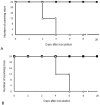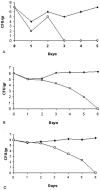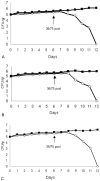Synergistic antibacterial and anti-inflammatory activity of temporin A and modified temporin B in vivo
- PMID: 19784377
- PMCID: PMC2747021
- DOI: 10.1371/journal.pone.0007191
Synergistic antibacterial and anti-inflammatory activity of temporin A and modified temporin B in vivo
Abstract
Temporins are antimicrobial peptides secreted by the granular glands of the European red frog (Rana temporaria). They are 10-14 amino acid long polypeptides active prevalently against gram positive bacteria. This study shows that a synthetic temporin B analogue (TB-YK), acquires the capacity to act in synergism with temporin A and to exert antimicrobial and anti-inflammatory activity in vivo against gram positive and gram negative bacteria. Administration of 3.4 mg/Kg of temporin A (TA)+1.6 mg/Kg TB-YK, given to individual mice concurrently with a lethal dose of bacteria (gram positive or negative), rescued 100% of the animals. More importantly, the same doses of temporins, administered one week after experimental infection with a sub lethal dose of bacteria, sterilized 100% of the animals within 3-6 days. Also, it is described an animal model based on the use of sub lethal doses of bacteria, which closely mimics bacterial infection in humans. The model offers the possibility to test in a preclinical setting the true potential of TA and TB-YK in combination as antimicrobial and anti-inflammatory agents.
Conflict of interest statement
Figures










Similar articles
-
Design, structural and functional characterization of a Temporin-1b analog active against Gram-negative bacteria.Biochim Biophys Acta. 2013 Jun;1830(6):3767-75. doi: 10.1016/j.bbagen.2013.01.026. Epub 2013 Feb 9. Biochim Biophys Acta. 2013. PMID: 23403136
-
Antibacterial, antifungal, anticancer activities and structural bioinformatics analysis of six naturally occurring temporins.Peptides. 2018 Aug;106:9-20. doi: 10.1016/j.peptides.2018.05.011. Epub 2018 May 26. Peptides. 2018. PMID: 29842923 Free PMC article.
-
Antimicrobial peptides from the skin of the Japanese mountain brown frog, Rana ornativentris.J Pept Res. 2001 Nov;58(5):349-56. doi: 10.1034/j.1399-3011.2001.00947.x. J Pept Res. 2001. PMID: 11892844
-
Temporins: An Approach of Potential Pharmaceutic Candidates.Surg Infect (Larchmt). 2020 May;21(4):309-322. doi: 10.1089/sur.2019.266. Epub 2019 Dec 4. Surg Infect (Larchmt). 2020. PMID: 31804896 Review.
-
Naturally Occurring Peptides from Rana temporaria: Antimicrobial Properties and More.Curr Top Med Chem. 2016;16(1):54-64. doi: 10.2174/1568026615666150703121403. Curr Top Med Chem. 2016. PMID: 26139114 Review.
Cited by
-
Antimicrobial Peptides and Their Therapeutic Potential for Bacterial Skin Infections and Wounds.Front Pharmacol. 2018 Mar 28;9:281. doi: 10.3389/fphar.2018.00281. eCollection 2018. Front Pharmacol. 2018. PMID: 29643807 Free PMC article. Review.
-
The antibacterial activity and therapeutic potential of the amphibian-derived peptide TB_KKG6K.mSphere. 2025 Jun 25;10(6):e0101624. doi: 10.1128/msphere.01016-24. Epub 2025 May 19. mSphere. 2025. PMID: 40387366 Free PMC article.
-
Identification of synthetic host defense peptide mimics that exert dual antimicrobial and anti-inflammatory activities.Clin Vaccine Immunol. 2012 Nov;19(11):1784-91. doi: 10.1128/CVI.00291-12. Epub 2012 Sep 5. Clin Vaccine Immunol. 2012. PMID: 22956655 Free PMC article.
-
The Antimicrobial Peptide Temporin G: Anti-Biofilm, Anti-Persister Activities, and Potentiator Effect of Tobramycin Efficacy Against Staphylococcus aureus.Int J Mol Sci. 2020 Dec 10;21(24):9410. doi: 10.3390/ijms21249410. Int J Mol Sci. 2020. PMID: 33321906 Free PMC article.
-
Analogs of the Frog-skin Antimicrobial Peptide Temporin 1Tb Exhibit a Wider Spectrum of Activity and a Stronger Antibiofilm Potential as Compared to the Parental Peptide.Front Chem. 2017 Apr 11;5:24. doi: 10.3389/fchem.2017.00024. eCollection 2017. Front Chem. 2017. PMID: 28443279 Free PMC article.
References
-
- Zasloff M. Antimicrobial peptides of multicellular organisms. Nature. 2002;415:389–395. - PubMed
-
- Boman HG. Antibacterial peptides: basic facts and emerging concepts. J Intern Med. 2003;254:197–215. - PubMed
-
- Levy SB, Marshall B. Antibacterial resistance worldwide: causes, challenges and responses. Nat Med. 2004;10:S122–129. - PubMed
-
- Papagianni M. Ribosomally synthesized peptides with antimicrobial properties: biosynthesis, structure, function, and applications. Biotechnol Adv. 2003;21:465–499. - PubMed
-
- Hancock RE. Cationic peptides: effectors in innate immunity and novel antimicrobials. Lancet Infect Dis. 2001;1:156–164. - PubMed

